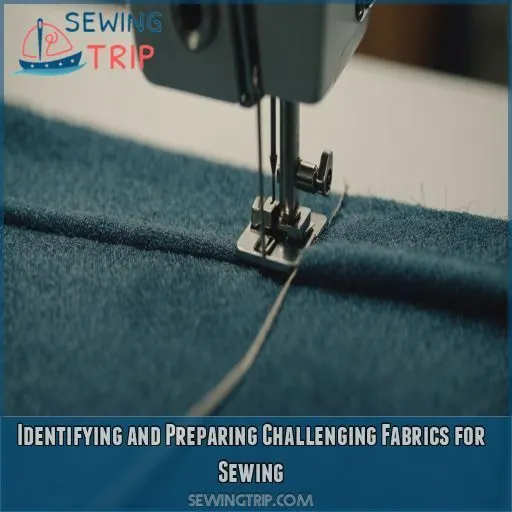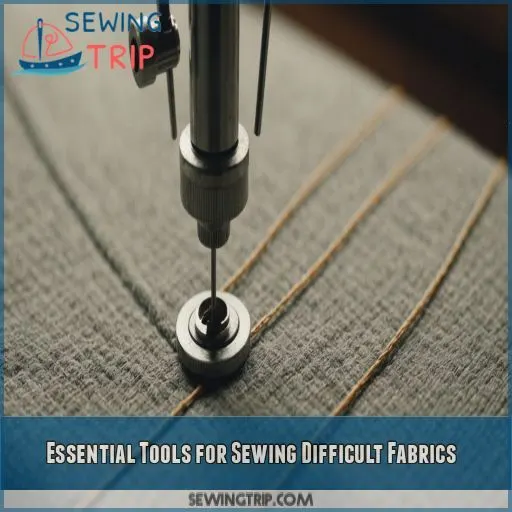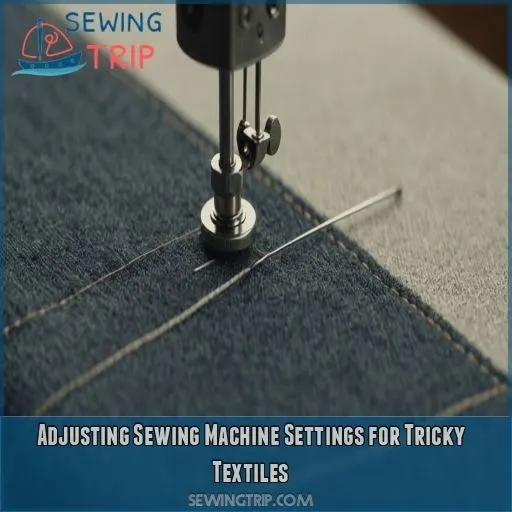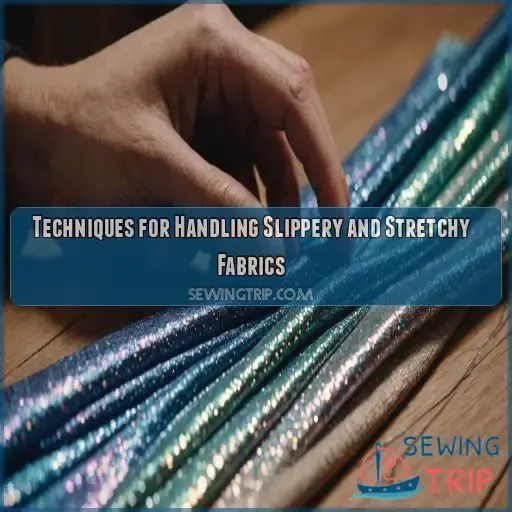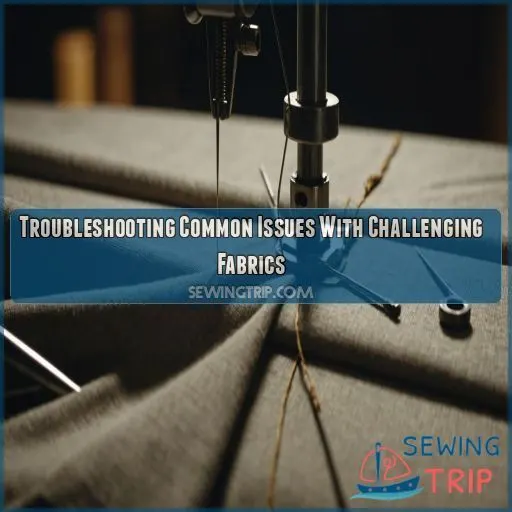This site is supported by our readers. We may earn a commission, at no cost to you, if you purchase through links.
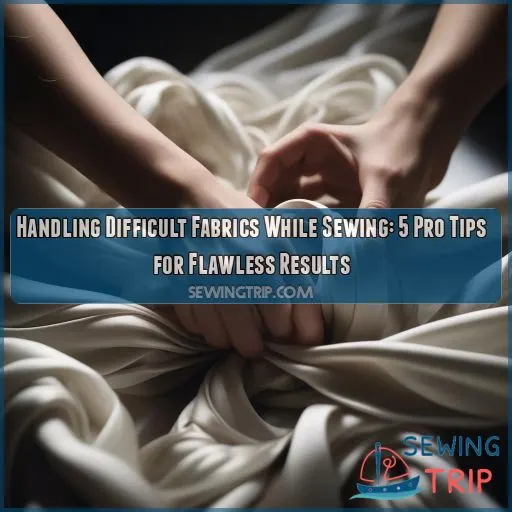
Don’t throw in the towel just yet!
With a few tricks up your sleeve, you’ll be conquering those tricky textiles in no time.
Start by getting to know your fabric’s quirks – is it stretchy, slippery, or heavy?
Then, arm yourself with the right tools, like specialty needles and presser feet.
Pre-washing is your secret weapon against surprises, and careful cutting is key to keeping things under control.
By mastering these techniques, you’ll transform those difficult fabrics from foes to fabulous fashion statements.
Ready to unravel the mysteries of sewing success?
Table Of Contents
- Key Takeaways
- Identifying and Preparing Challenging Fabrics for Sewing
- Essential Tools for Sewing Difficult Fabrics
- Adjusting Sewing Machine Settings for Tricky Textiles
- Techniques for Handling Slippery and Stretchy Fabrics
- Troubleshooting Common Issues With Challenging Fabrics
- Frequently Asked Questions (FAQs)
- Conclusion
Key Takeaways
- Know your enemy: Get cozy with your fabric’s quirks before you start. Is it slippery as an eel or stretchy as a rubber band? Understanding your textile’s temperament is half the battle won!
- Gear up like a pro: Arm yourself with the right tools for the job. From specialty needles to fancy feet, having the proper equipment is like bringing a Swiss Army knife to a fabric fight.
- Prep like you mean it: Pre-washing isn’t just a suggestion, it’s your secret weapon against shrinkage surprises. And remember, careful cutting is the name of the game – it’s like giving your fabric a stylish haircut!
- Adjust and conquer: Your sewing machine isn’t psychic (wouldn’t that be nice?), so you’ll need to tweak those settings for each tricky textile. Play with tension, stitch length, and pressure until you find that sweet spot. It’s like finding the perfect dance partner for your fabric!
Identifying and Preparing Challenging Fabrics for Sewing
You’ve picked out a beautiful but tricky fabric for your next sewing project – now what? Don’t panic; with the right preparation techniques and a few insider tips, you’ll be ready to tackle even the most challenging textiles like a pro.
Recognizing Common Difficult Fabrics
Ever felt like your fabric’s got a mind of its own? You’re not alone! Recognizing tricky textiles is half the battle. Here are some common culprits that’ll test your sewing skills:
- Slippery silks that slide around like butter on a hot pan
- Stretchy knits that grow faster than a kid in a growth spurt
- Delicate synthetics that snag if you so much as look at them funny
Don’t worry, though. With the right know-how, you’ll be taming these fabric beasts in no time!
Pre-washing and Fabric Treatment Techniques
Before you start your sewing project, give your fabric some TLC. Pre-washing is your secret weapon against nasty surprises like shrinkage or color bleeding. Here’s a quick guide to get you started:
| Fabric Type | Pre-wash Method | Treatment Tips |
|---|---|---|
| Cotton | Machine wash | Use color catcher sheets |
| Silk | Hand wash | Test for colorfastness |
| Wool | Dry clean | Steam to pre-shrink |
Proper Cutting Methods for Tricky Textiles
Ready to tackle those tricky textiles?
First, tame that fabric grain like a lion tamer! Align your shears just right, and you’ll be cutting through silk like butter.
Don’t forget pattern matching – it’s your secret weapon for pro-level results.
Layer your fabric carefully, and choose the right cutting tools for each material.
Selecting Appropriate Interfacing and Stabilizers
Choosing the right interfacing and stabilizers is like finding the perfect dance partner for your fabric.
Consider your fabric’s weight and your project’s needs.
Lightweight interfacing is perfect for delicate silks, while heavyweight interfacing is ideal for sturdy denim. It’s all about balance.
Fusible or sew-in? That depends on your fabric’s temperament.
Organizing Your Workspace for Challenging Materials
Now that you’ve got your fabrics and stabilizers sorted, let’s talk about setting up your sewing space for success. Taming tricky textiles is all about creating a workspace that’s as smooth as silk. Here are three key things to think about:
- Clear, spacious work surface
- Bright, adjustable lighting
- Easy-to-reach tool storage
Essential Tools for Sewing Difficult Fabrics
Sewing tricky fabrics can be a real challenge, but having the right tools can make a world of difference. Let’s explore the essential equipment you’ll need to tame those challenging materials and turn them into stunning creations with ease.
Specialized Sewing Machine Feet
Now that you’ve prepped your tricky fabrics, let’s talk about your sewing machine’s secret weapons: specialized feet.
These nifty attachments are like Swiss Army knives for your machine, each designed to tackle specific fabric challenges.
From the walking foot that keeps layers in sync to the roller foot that glides over sticky materials, you’ll find a perfect match for every textile temperament.
Choosing the Right Needles for Each Fabric
Now that you’ve got the right foot, let’s talk needles.
It’s like picking the perfect dance partner for your fabric!
A universal needle might seem like a jack-of-all-trades, but it won’t cut it for tricky textiles.
Grab a needle size chart and match it to your fabric weight.
Keep your needle sharp and swap it out regularly for smooth sailing!
Thread Selection for Optimal Results
Now that you’ve got the right needle, let’s talk thread. It’s like finding the perfect dance partner for your fabric! Thread weight, type, and finish can make or break your project. For slippery silks, try a fine polyester thread. Stretchy knits? Go for woolly nylon. And don’t forget about color – sometimes a contrasting thread can add that extra pop!
Fabric-specific Marking Tools and Techniques
Ever felt like you’re playing pin the tail on the donkey with fabric markers? Fear not! For slippery silks, try water-soluble pens that vanish with a dab of H2O.
For dark, delicate fabrics, chalk wheels are your best friend – they glide on like butter and brush off easily.
And for those pesky knits? Grab some tailor’s tacks; they’ll stick around until you’re ready to bid them farewell.
Pressing Equipment for Delicate Materials
For pressing delicate fabrics, your iron’s not the only star of the show.
A pressing cloth is your fabric’s bodyguard, shielding it from direct heat.
Grab a tailor’s ham for those curvy seams – it’s like yoga for your garment!
And don’t forget a sturdy pressing board; it’s the stage where all the magic happens.
Adjusting Sewing Machine Settings for Tricky Textiles
When you’re tackling tricky textiles, your sewing machine’s settings are your secret weapon. By fine-tuning tension, stitch length, and presser foot pressure, you’ll transform even the most challenging fabrics into stunning creations that’ll make your friends wonder if you’ve got magical sewing powers.
Tension Adjustments for Different Fabrics
Ever feel like your sewing machine’s throwing a tantrum? It might just need a tension tweak!
Different fabrics demand different tension settings.
Light fabrics like silk? Loosen up that tension dial.
Heavy denims? Crank it up a notch.
It’s all about finding that sweet spot where your stitches look perfect on both sides.
Stitch Length and Width Considerations
When tackling tricky fabrics, don’t underestimate the power of stitch length and width!
For slippery silks, shorten your stitch length to prevent puckering.
Stretchy knits? Go longer to allow for movement.
It’s like finding the perfect dance partner for your fabric – too short, and you’ll trip; too long, and you’ll lose control.
Experiment and find your fabric’s rhythm!
Adjusting Presser Foot Pressure
Adjusting your presser foot pressure is like finding the sweet spot on your favorite chair – it’s all about balance. Too much pressure can leave your fabric looking like it’s been through the wringer, while too little might’ve it wandering off on its own adventure. Here’s how to nail it:
- Light fabrics: Ease up on the pressure to avoid puckering
- Heavy fabrics: Increase pressure for better feed
- Stretchy fabrics: Find a middle ground to prevent stretching
Feed Dog Modifications for Smooth Sewing
Ever felt like your fabric’s fighting your feed dogs? You’re not alone!
Different feed dog types can make or break your sewing experience.
Try lowering or covering them for slippery fabrics – many sewing machine brands offer easy DIY modifications.
Troubleshooting issues? A piece of tissue paper under your fabric can work wonders.
Using Specialty Stitches for Challenging Materials
Now that you’ve tamed those feed dogs, let’s talk specialty stitches. They’re your secret weapons for tricky fabrics. Here’s why they’re game-changers:
- They’ll make you feel like a sewing superhero
- You’ll conquer fabrics you once feared
- Your projects will look pro-level amazing
Experiment with different stitches for each fabric type. A stretch stitch for knits or a narrow zigzag for silks can be the difference between a hot mess and a masterpiece.
Techniques for Handling Slippery and Stretchy Fabrics
You’ve mastered basic sewing, but slippery and stretchy fabrics still give you nightmares? Don’t worry – with the right techniques, you’ll be taming those tricky textiles in no time. From clever pinning tricks to stretchy-fabric hacks, these pro tips will help you sew even the most challenging materials with confidence.
Pinning and Basting Strategies
Ever felt like your fabric’s playing a game of "catch me if you can"? You’re not alone!
Tame those slippery and stretchy troublemakers with some pinning and basting wizardry.
Start by using fabric weights to keep things in place while you work your magic.
When pinning, place them perpendicular to the seam allowance – it’s like giving your fabric a firm handshake.
For extra control, baste those tricky areas before stitching.
Trust me, your sewing machine will thank you!
Preventing Puckering and Rippling
Ever battled with puckered seams? You’re not alone!
To prevent fabric from throwing a tantrum, start with the right fabric choice.
Adjust your seam allowances and keep a keen eye on tension control.
For a polished look, master top stitching. It’s like giving your fabric a pep talk – smooth and well-behaved is the goal!
Managing Fabric Stretch During Sewing
Working with stretchy fabrics can feel like trying to wrangle a slippery eel, but don’t worry!
Keep your fabric’s grain aligned and use a walking foot to prevent layers from shifting.
Adjust your pattern’s seam allowance for extra wiggle room, and consider sizing down for a snug fit.
You’ve got this, fabric whisperer!
Seam Finishing Methods for Delicate Fabrics
- Embrace the elegance of French seams for a polished look
- Get creative with bias tape for a pop of color and strength
- Master the art of hand-stitching for ultimate control
Hemming Techniques for Difficult Materials
Hemming tricky fabrics can feel like taming a wild beast, but don’t sweat it! We’ve got your back with these pro techniques. Whether you’re dealing with slippery silk or stubborn leather, there’s a trick for every textile. Check out this handy table for quick tips:
| Fabric Type | Recommended Technique | Pro Tip |
|---|---|---|
| Sheer | Rolled hem | Use a ban-roll foot |
| Velvet | Blind hem | Press on a needle board |
| Leather | Topstitched hem | Skip pins, use clips instead |
Troubleshooting Common Issues With Challenging Fabrics
Even seasoned sewers can encounter hiccups when working with tricky fabrics. Let’s explore some common issues you might face and learn how to troubleshoot them like a pro, ensuring your projects turn out beautifully every time.
Dealing With Skipped Stitches and Uneven Seams
Now, let’s tackle those pesky skipped stitches and uneven seams. They’re like uninvited guests at your sewing party!
First, check your needle – is it the right type and size for your fabric? A dull or wrong-sized needle can cause havoc.
Next, make sure your thread tension is spot-on. Too tight, and you’ll get puckers; too loose, and you’ll have gaps.
Don’t forget to clean your machine regularly – lint buildup can cause all sorts of mischief!
Preventing Fabric Distortion and Warping
Now that you’ve tackled those pesky skipped stitches, let’s keep your fabric looking sharp! Preventing distortion and warping is like keeping your fabric’s secret shape intact. Here are three key tricks to keep your fabric from throwing a tantrum:
- Mind the grain: Cut and sew along the fabric’s natural lines.
- Press, don’t stress: Use gentle heat and a pressing cloth.
- Easy does it: Control tension and seam allowance for smooth sailing.
Managing Fabric Slippage During Sewing
Fabric slipping around like a greased pig? Don’t worry, we’ve all been there.
To tackle slippery fabrics, try using a walking foot or even hand-basting before machine sewing.
Pin generously, and consider using tissue paper underneath your fabric.
For extra grip, spritz your fabric with spray starch or use a stabilizer.
Addressing Puckering and Gathering Problems
Ever felt like your fabric’s throwing a temper tantrum?
Puckering and gathering can make you want to tear your hair out!
But don’t fret – we’ve got your back.
To tame those rebellious seams, try adjusting your fabric tension and double-check those seam allowances.
A good pressing technique can work wonders too.
Fixing Snags and Runs in Delicate Fabrics
Snags and runs in delicate fabrics can make you want to throw in the towel, but don’t fret!
With a few fabric repair techniques up your sleeve, you’ll be a mending maestro in no time.
Grab your trusty mending tools and get ready to work some magic.
From snag prevention tips to run repair methods, we’ll show you how to handle these pesky problems like a pro.
Frequently Asked Questions (FAQs)
How do you prevent puckering when sewing delicate fabrics?
You might think puckering’s inevitable, but it’s not! Use a walking foot, lighten presser foot pressure, and adjust thread tension. Stabilize with tissue paper underneath. Short stitches and gentle handling are your secret weapons against pesky puckers.
What interfacing works best for sheer or lightweight materials?
For sheer or lightweight materials, you’ll want to use a featherweight fusible interfacing. It’s your secret weapon for adding structure without bulk. Just remember, less is more – you don’t want to weigh down your airy fabrics!
Can difficult fabrics be sewn without a serger?
Don’t let tricky fabrics scare you off. With the right techniques, you can tame those slippery devils without a serger. Try French seams, pinking shears, or zigzag stitches to keep your edges neat and fray-free.
How to choose the right needle for specialty fabrics?
Imagine you’re working with silk chiffon, and your needle is causing snags. Yikes! To choose the right needle, match the size to your fabric’s weight. For delicate materials, opt for smaller sizes like 60/8 or 70/ You’ve got this!
Are there alternatives to pins for delicate fabrics?
You’ve got options! Try fabric weights, pattern weights, or wonder clips. For super delicate fabrics, use wash-away tape or basting spray. These alternatives won’t leave holes and will keep your precious fabrics looking pristine. Give ’em a whirl!
Conclusion
Did you know that 65% of sewers struggle with difficult fabrics? You’re not alone!
By mastering the art of handling difficult fabrics while sewing, you’ll open up a world of creative possibilities.
With these pro tips in your arsenal, you’ll conquer even the trickiest textiles with confidence.
So, grab that slippery silk or stretchy knit, and get ready to transform it into a stunning masterpiece.
Happy sewing, and may your stitches always be straight!

